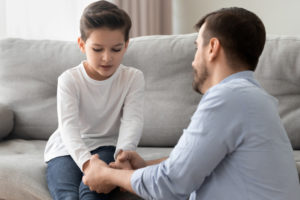Strategies to Get Children to Listen and Take Responsibility
Written by: Shaquanta “Shelley” Shelley, M.S.

It can be a battle getting kids to do things they are supposed to do. It gets even more frustrating when kids know the expectations but choose not to do them. Having to remind kids repeatedly to complete tasks like homework, chores, and other responsibilities can be a daily challenge. Check out the steps below to help get your child to listen:
Teach your child proactively.
It is best to teach kids when a situation is NOT happening rather than teaching them as it is happening. While the situation is happening, parents are likely experiencing their own feelings/emotions as well as the child.
Don’t let your child know in the moment your judgments or criticism toward the behavior.
At the moment, kids are thinking about their feelings and what they want to do. They will likely not listen to reason and are unable to because they may be overwhelmed by their emotions. Kids will likely not hear how they are wrong in this moment because they are consumed with their feelings to tend to their own wants and needs.
Focus on yourself and not the child.
Use this as an opportunity to model for kids what it looks like when things are not going our way and how to remain calm. Kids are sponges and learn from what they see. If they notice adults getting upset about situations they cannot control (i.e., kids not following rules), kids learn that they can also get upset when things don’t go their way. If we want our kids to still be mature during challenging moments, we must also show them what it looks like to remain mature when facing these situations.
Don’t get sucked into your child’s reaction.
Often, we see our child react then we react. We create a cycle of reactions from one another’s behaviors, emotions, and feelings. As a result, nothing gets accomplished because we are all now distracted and no longer focused on the goals but focused on what is going on internally for us. Mindful exercises (i.e., deep breathing, reminding yourself of the goal, taking a break, counting, taking a walk, etc.) are helpful to get your thoughts away from focusing too much on the behaviors, emotions, and feelings.
Model the behavior you want to see.
It is easier for kids to do something when they see it reflected. In modeling, you teach your child not to get stuck when facing difficult situations within themselves or with others. Modeling using mental/mindful exercises can also be beneficial for the child to see so they can learn to use them and be encouraged to find what works best for them.
These steps can be demanding, especially when first starting out. None of us are robots. We all experience emotions. Give yourself grace and take steps to manage emotions, identify them, and address them rather than exploding or ignoring them. These steps not only help your child learn healthier responses and reactions, but they will also help you remain calmer. These steps are not intended to allow the child to get away with not doing their chores or responsibilities, but rather to enforce a new standard on handling frustrations and challenging moments to get goals accomplished.
